Currently,the Chinese government is leading a drug pricing reform with a major problem to be solved: the high retail prices of drugs. Before the drug pricing reform, the government permitted hospitals to add a 15% markup to pharmaceutical wholesale prices to sell. The price markups result in serious problems such as encouraging medical institutions to use more drugs or even more expensive drugs, which results in a rapid rise in medical costs and increased burdens for both the government’s medical insurance fund and patients. This is commonly called drug-maintaining-medicine.
The Chinese government has removed the previous 15% markup for drug sales at hospitals, hoping that the hospitals will not make a profit from selling drugs and to predictably reduce unreasonable drug use[1]. This drug pricing reform was officially launched from September 2017 and since then hospital drugs must be sold at wholesale prices. Simultaneously, to let hospitals make both ends meet, the health department increases the prices of outpatient fees. For instance, the Beijing government announced that all medical institutions involved in the reform will have abolished price markups from April 8, 2017. Meanwhile, outpatient fees will increase from 10 to 30 Yuan or more according to the doctors’ levels[2]. Such measures may prevent over prescription, but it is foreseeable that a substantial increase in the outpatient fees will increase the purchasing cost of drugs, which is against the original intention of the reform. Chen et al.[3] declared that the drug spending dropped after reform, but total spending during this period increased by 6.88% per patient.
Based on the analysis of the drug pricing reform, we introduce a business model of pharmaceutical e-commerce to improve the effect of the reform. Thus, there are three channels for patients to purchase drugs in our innovative model: Hospitals, e-pharmacies and drugstores. However, the problem is that a profitable model for the e-pharmacy has not been found . As reported by the Chinese Food and Drug Administration, the average profit margin of e-pharmacies was -5.5% in 2016[4]. The main reason for the unprofitability is high home-delivery costs because the online orders need to be delivered in a short time after purchasing. For example, Dingdang Medicine Express claims home delivery in 28 min. In 2018, its income reached 10 million Yuan but with a net loss of 50 000 Yuan. To improve the effect of the pricing reform, we have to design a mechanism to solve the problem of pharmaceutical e-commerce profitability at the beginning.
A coordination solution between the e-pharmacy and the drugstore called “order online, delivery by drugstore” (OODD) is proposed in this paper, which enables the patients to obtain ordered drugs in a short time. In addition, the cost of home-delivery can be reduced greatly. To ensure that the e-pharmacy cooperates with the drugstore well, we introduce a fixed service fee, which means that the e-pharmacy pays a fixed service fee to the drugstore for each online order. Then, we derive a feasible range of the cooperative fees so that both the drugstore and the e-pharmacy increase their respective profits. As for the managerial implications, if the range of cooperative fee is not empty, the implementation of the OODD strategy is feasible. With this in mind, the e-pharmacy and the drugstore can effectively negotiate an OODD coordination scheme to achieve a win-win situation instead of pricing with irrationality, which can eventually lead to the loss of profits.
In summary, this paper focuses on the inefficient drug pricing reform. To improve the effect of the reform, we introduce pharmaceutical e-commerce into the pharmaceutical supply chain, and design a service compensation mechanism to realize supply chain coordination.
1 Literature Review
We generalize the related literature about the reform of drug pricing and supply chain coordination as the basis of our research.
First, there are a few articles on Chinese drug pricing reform. The reform has reduced the retail prices of drugs. Yang et al.[5]expressed that the zero-profit drug policy has effectively reduced the retail price of drugs dispensed from primary care organizations, and it is estimated that the price of medicines might have fallen by an average of 30%. Yi et al.[6] indicated large reductions in drug revenues after reform through collecting representative data from China’s township health centers. Luan et al.[7] showed that the policy puts financial pressure on hospitals, as their revenue from prescription drugs per patient decreases significantly. However, some scholars believe that the effect of reform is not significant. Liu et al.[8] investigated the outcomes of Zhejiang’s zero-markup policy, thus predicting the effect of the policy on health expenditures. In addition, the statistical results show that the drug expenditures in sample hospitals have decreased by 7.78%. A similar result is obtained in western rural China by Zhou et al.[9] Regarding the flow of patients. Shi et al.[1] collected the actual data from all traditional Chinese medicine (TCM) county hospitals, and the statistics show that the zero-markup drug policy was not significantly associated with the number of annual outpatient and inpatient visits. Zeng et al.[1] showed that the decline in total expenditure is weakened by the substitution effect of medical consumables in the long-term.
Furthermore, other researchers argue that the reform increases patient costs. For instance, Yang et al.[11] assessed the effects of a zero-markup drug policy on hospitalization expenditures based on data from a western Chinese city. The results show that the hospitalization expenditures are still rising. Wang et al.[12] conducted questionnaire surveys in 60 hospitals and found that the average medical expense per outpatient and per inpatient increased by 25.93% and 25.22%, respectively.
Although the above studies focus on the drug pricing policy, they obviously have some limitations. Firstly, these articles only examine the drugs’ retail price in a hospital. In fact, pharmacies also hold considerable shares in the drug retail market, especially common drugs. Secondly, the research methods of the existing articles are surveys and statistics, which are restricted by small sample sizes. Moreover, there is no research in analyzing the drug pricing reform from a theoretical perspective. Thirdly, none of the above studies considers the new mode of pharmaceutical e-commerce. The introduction of pharmaceutical e-commerce will certainly produce new scenarios and problems. In contrast to the literature above, this paper will analyze the issue of drug pricing based on a mathematical model of the pharmaceutical supply chain. This is a new way of addressing the problem of drug pricing reform.
The second area of this paper focuses on the coordination of online and offline channels. The common coordination methods are as follows: Quality discounts contracts, revenue-sharing contracts, profit-sharing contracts etc. For example, Saha et al.[13] proposed a three-way discount mechanism employed in a closed-loop dual-channel supply chain, for acquiring used products earmarked for remanufacture. Xu et al.[14] proposed a two-way revenue-sharing contract, which can coordinate the dual-channel supply chain and ensure both supply chain members to achieve a win-win situation. Xiao et al.[15] studied the equilibrium decisions in the supply chain with an all-unit quantity discount contract. There are also articles that adopt a coordination strategy similar to that in this paper. Liao et al.[16] designed a revenue-sharing contract for hotels and online travel agencies under the merchant and the agency models, respectively. Dan et al.[17] proposed a cost sharing contract to realize Pareto improvements in a service-based free-riding dual-channel supply chain. Dumrongsiri et al.[18] pointed out the fact that the manufacturer and the retailer coordinate and follow a centralized decision maker, which adds a direct channel, thus increasing the overall profit. Amrouche et al.[19] analyzed the minimum pricing strategy, the whole channel price, and the revenue sharing cooperation in a dual-channel supply chain when a dominant manufacturer owns and controls the traditional retailer. Pei et al.[20] studied the value of information sharing between the manufacturer and the e-retailer, and showed that the cooperative wholesale price with profit sharing is a double-win strategy to eliminate information distortion. Chen et al.[21] focused on an online and offline pricing mode of retailing based on the power structure of the retailing service supply chain.
The studies above mainly focused on the stage of commodities sales, and there are also considerable studies in the delivery phase. Gao et al.[22] developed a model in which a retailer operates in both online and offline channels and they studied the impact of the buy-online-and-pick-up-in-store (BOPS) strategy on retailer operations. Gallino et al.[23] empirically investigated the impact of buying online and pickup in store on a retailer’s sales in both online and offline channels. Interestingly, they find that the implementation of BOPS is associated with the reduction in online sales and increase in store sales and traffic. Liu et al.[24] studied the pricing and ordering strategies when considering online returns in an omni-channel model. Jiang et al.[25] indicated that the service value of a physical store strongly influences the players’ pricing strategies in a BOPS model. Zhang et al.[26] studied the preorder-online, pickup-in-store (POPU) strategy for a dual-channel retailer. The result shows that the retailer should choose products with a high value and a low degree of customer acceptance of the online channel for POPU.
The modeling approaches in the literature of supply chain coordination unfolded above are almost based on the dual-channel model. In comparison with previous research,this study proposes a three-channel coordinative supply chain model. The increase in one channel will lead to greater complexity in model setting and solving. However, this coordination scenario is popular in reality.
2 Models and Analysis
In this section, we establish three models (see Figs.1 to 3). Fig.1 describes the situation before the drug pricing reform. As the patient can buy drugs from two channels; i.e., drugstores and hospitals, we call it a dual-channel model before reform. Fig.2 represents the current situation after drug pricing reform, so it is called a dual-channel model after reform. The main differences are the eliminated pharmaceutical price margin in the hospital channel and the increased outpatient fees. Fig.3 is a multi-channel coordination model, which adds a pharmaceutical e-commerce channel to it. Therefore, the proposed model is defined as a multi-channel model after reform. In the following, we will study these three models in detail and then analyze the pharmaceutical pricing reform based on the models.
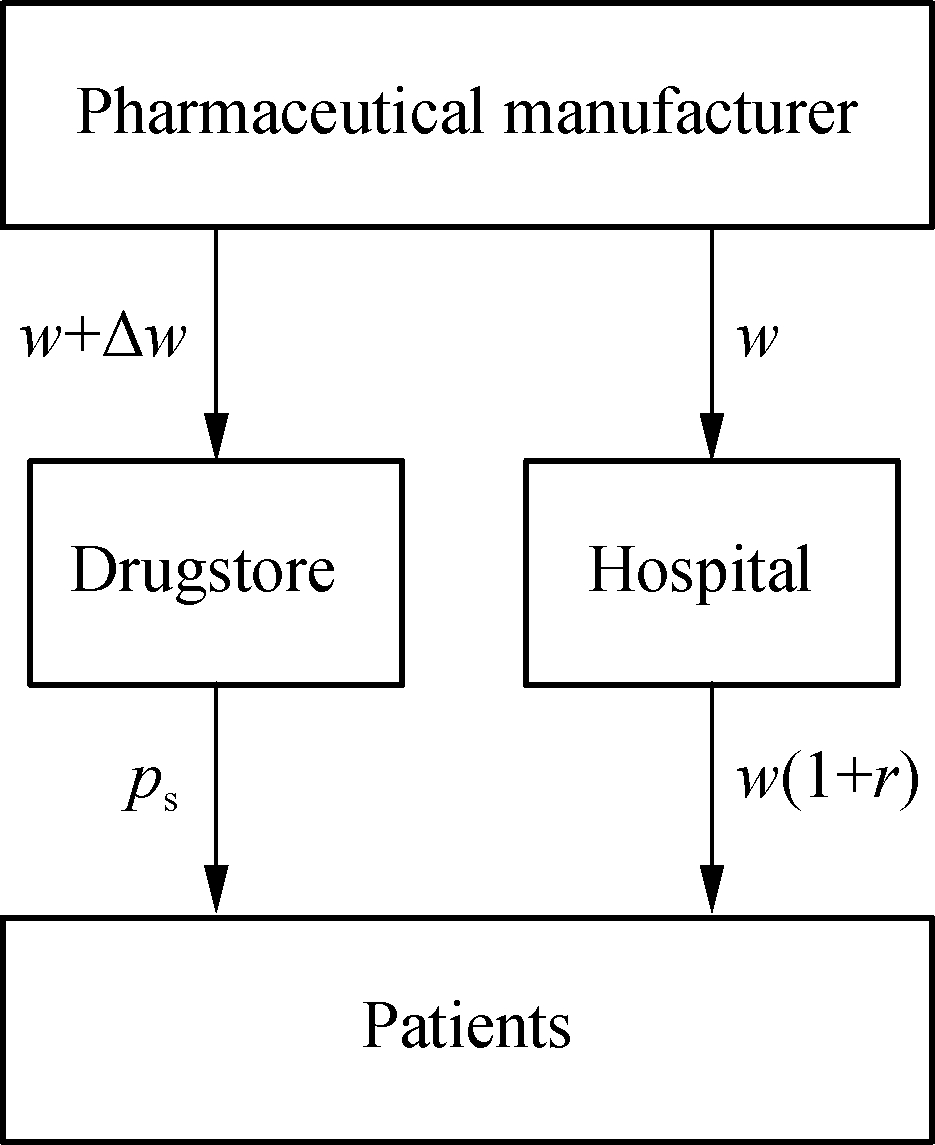
Fig.1 Dual-channel model before reform

Fig.2 Dual-channel model after reform
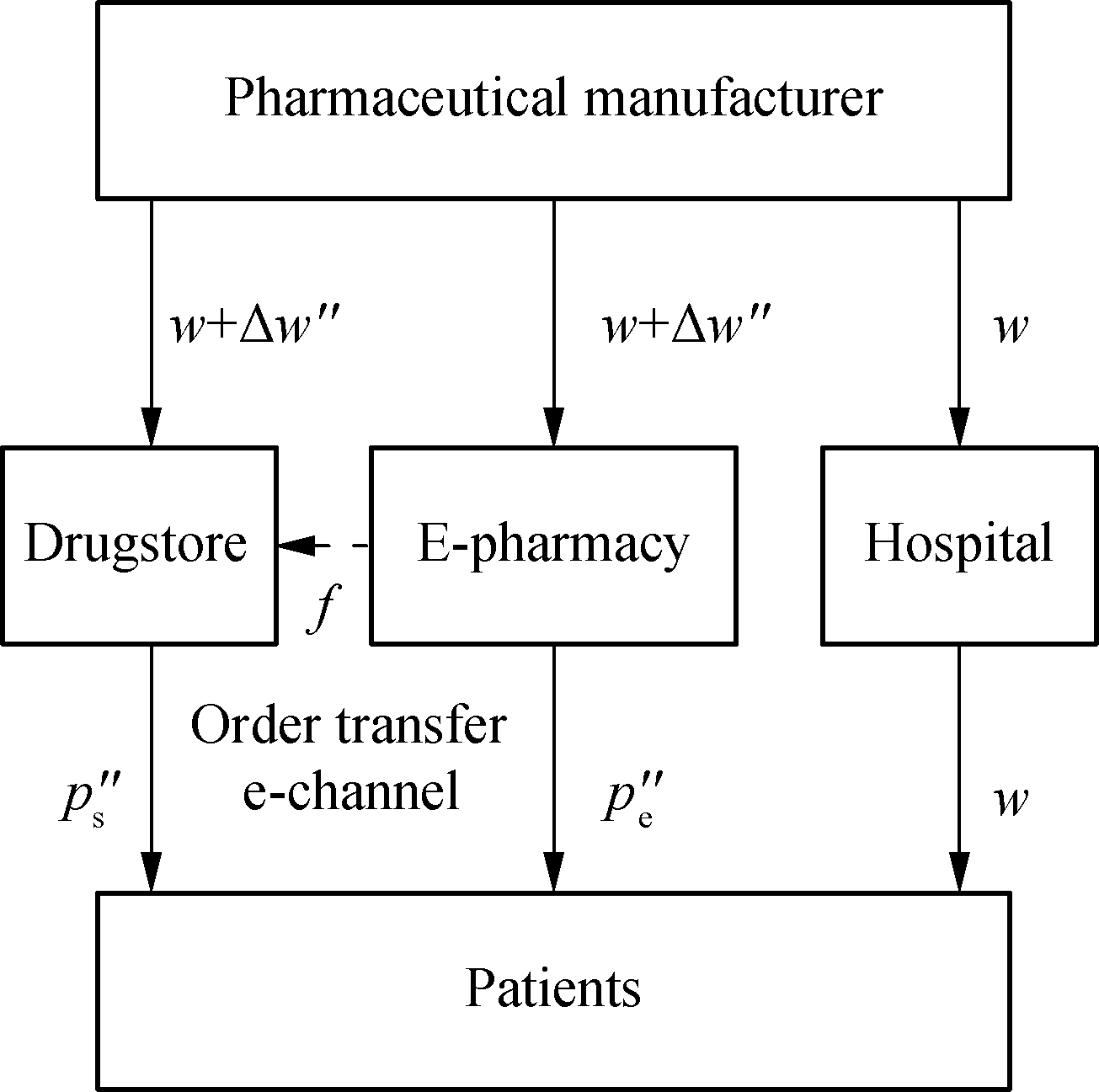
Fig.3 Multi-channel model after reform
The dual-channel model before reform indicates that patients can purchase drugs from a drugstore or hospital. The retail price of drugstores is ps, and the retail price of hospitals is w(1+r), where r is the pharmaceutical price margin. In addition, both the drugstore and hospital buy wholesale from the pharmaceutical manufacturer. As the negotiating abilities of the drugstore and hospital are different, their wholesale prices also vary. w represents the wholesale price of the hospital and Δw represents the wholesale price difference between the retailer and the hospital. For the wholesale market, the pharmaceutical manufacturer determines the wholesale price difference Δw for drugstore, while the hospital determines the wholesale price w. In China, the vast majority of hospitals are run and managed by the government. In the procurement of hospital drugs, the provincial government centralizes the pharmaceutical demand of the hospitals, then adopts a centralized bidding approach to determine the wholesale price. Afterwards, hospitals place orders in this drug-purchasing system. Considering the bargaining power of the government and market competition, the wholesale price to the hospital is set by the hospital, not the manufacturer.
In the pharmaceutical retail market, the retail price at the drugstore is determined by the drugstore, while the retail price at hospitals is the wholesale price plus a 15% price margin for government controls. Additionally, if a patient chooses the hospital channel to buy drugs, he/she has to pay outpatient fees for doctors’ consultations.
In the dual-channel model after reform, the retail price at hospital equals the wholesale price since the drug pricing reform forces the hospital to cancel the 15% price margin. At the same time, to divert patients with minor ailments, the outpatient fees are increased greatly by the hospital. Facing the new business environment, the pharmaceutical manufacturer resets the wholesale price for the drugstore. The wholesale price of the hospital remains unchanged due to market competition and the government’s strong bargaining power.
The multi-channel model after reform shows that a pharmaceutical e-pharmacy enters the drug retail market. According to the provisional regulation on the approval of the internet drug business, the e-pharmacy must have offline physical pharmacies, and thus the e-pharmacy is also a pharmaceutical retailer. Here, we assume that the e-pharmacy and the offline drugstore have the same bargaining power. Therefore, the drugstore and the e-pharmacy buy wholesale drugs from pharmaceutical manufacturers at the same wholesale price, and then sell them online and deliver them to patients. He/she controls the online retail price pe. To realize “order online, delivery by drugstore” coordination, the offline drugstore earns a fixed service compensation f from the e-pharmacy. In this paper, different upper cornermarks are used to distinguish between diverse scenarios.
2.1 Modeling
In modeling, most scholars use price-demand function[27-29] or channel-utility function[26,30-31]. In this paper, Hotelling’s linear street models, which is a utility function, is applied to simulate the market environment. Compared with the price-demand function, the reasons for choosing the Hotelling model are: 1) The total number of patients remains basically unchanged; 2) The three-channel model constructed has fewer parameters to be analyzed. Thus in the following Hotelling model, the drugstore is located at an initial point x=0; conversely, the hospital is located at a terminal point x=1, and the patients are distributed uniformly along this interval. Then, we construct the patient utility function of each channel. By comparing the patient utility of each channel, the patients can make choices.
Three components are considered for the selection of the drug-purchasing channel: Pharmaceutical utility, distance and costs. We suppose that V is the pharmaceutical utility, and it should be sufficiently large to ensure that the patient buys at least once. When patients go to the drugstore or hospital to buy medicines, they need to spend time and endure pain in the meantime. When the distance is longer, the negative effect is greater. Thus, we suppose that the generated negative utility is linear with the distance, and the distance coefficient is set to be a. Moreover, when the patient orders medicines online, during the home-delivery trip, the patient can rest at home and wait a short time to receive the orders. Thus, we assume that the negative effect of the distance does not exist in the e-channel. The costs are the pharmaceutical retail prices of each channel. Additionally, when the patient goes to hospital, the outpatient fee o is required. As shown in Fig.4, under the dual-channel model, the patients can choose the drugstore or the hospital to buy drugs. In contrast, under the multi-channel model, some patients in the middle who are far away from the drugstore and hospital probably choose the e-pharmacy channel to buy drugs (see Fig.5).
By the model of market share and the patient utility of each channel,we can obtain the patient’s decision expres-sion. Under the dual-channel model before the reform, the patient’s decision expression is formulated as follows:

Fig.4 Market share taken by two channels
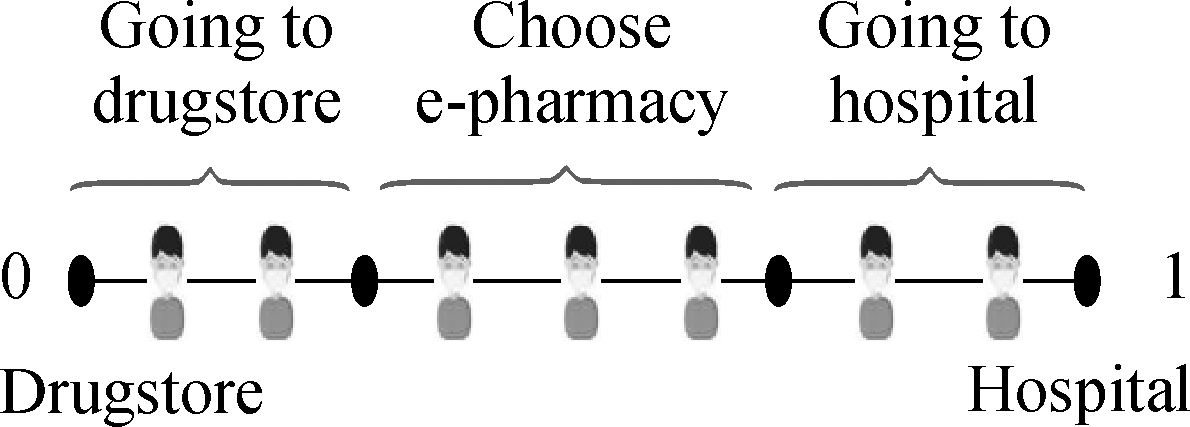
Fig.5 Market share taken by three channels
max[V-ax-ps,V-a(1-x)-w(1+r)-o]
(1)
Let V-ax-ps=V-a(1-x)-w(1+r)-o, and we obtain ![]() which represents the market demarcation point between the drugstore and hospital. With this cut-off point, the expressions of drugstore’s profit πs, hospital’s profit πh and manufacturer’s profit πm are shown, respectively:
which represents the market demarcation point between the drugstore and hospital. With this cut-off point, the expressions of drugstore’s profit πs, hospital’s profit πh and manufacturer’s profit πm are shown, respectively:
πs=(ps-w-Δw)
(2)
πh=(o+wr)(1-x)
(3)
πm=(w+Δw)x+w(1-x)
(4)
To find the optimal decision variables, the decision process is assumed as follows: The manufacturer, as a leader, determines the price differentiation of the wholesale price to drugstore Δw. Then, the drugstore, as a follower, sets its optimal retail price ps. According to profit maximization, we first obtain optimal ps by ∂πs/∂ps=0 and substitute ps into manufacturer’s profit πm. Then, we obtain optimal Δw by ∂πm/∂Δw=0. Thus, all the optimal decision variables in the first model are solved. For the solution of the optimal values under the dual-channel model after the reform, we just set the pharmaceutical price margin of hospital r=0 and the outpatient fee after reform to be increased to o′.
Under the multi-channel coordination model, the patient’s decision expression, the expressions of profits and the decision process are different from the two models above. In the multi-channel coordination model, the patient decision expression is determined by
(5)
To search the cut-off point of patients’ utility, we have
(6)
(7)
where x1 represents the market demarcation point between the drugstore and the e-pharmacy, and x2 represents the market demarcation point between the e-pharmacy and the hospital.
Hence, the expressions of profits are as follows:
(8)
(9)
(10)
(11)
where ce is the home-delivery cost of the drugstore. Using the same method, the optimal decision variables can be acquired under the multi-channel model.
Thus, we have solved the quantity of patients and the retail prices in different channels under the three models. In the following, we will analyze the effect of the drug pricing reform and discuss how to improve the effect.
2.2 Effect of drug pricing reform
To analyze the effect of the drug pricing reform, we compare the optimal values before and after the reform. The comparison is shown in Tab.1.
Tab.1 Comparison of market parameters

ParameterBefore reformAfter reformDifferencesxa+o+wr8aa+o'8ao'-o-wr8aΔwa+o+wr2a+o'2o'-o-wr2ps3(a+o)+4w+3wr43(a+o')+4w43(o'-o-wr)4πh-(o+wr)(-7a+o+wr)8a-o'(-7a+o')8a-(o'-o-wr)(o'+o+wr-7a)8aπs(a+o+wr)232a(a+o')232a(o'-o-wr)(o'+o+wr+2a)32aπm(a+o+wr)216a+w(a+o')216a+w(o'-o-wr)(o'+o+wr+2a)16a
Proposition 1 When the increment of the outpatient fee is greater than the abolition of the price margin, the drug pricing reform can divert patients from the hospital to the drugstore; meanwhile, the drug pricing reform increases the retail price of the drugstore.
To divert patients, o′-o-wr>0 must be obeyed, which means that the increment of the outpatient fee is greater than the abolition of the price margin. We have x′-x>0, ![]() which indicates the increase in the drugstore’s market share, retail price and profit, respectively. Therefore, the drug pricing reform is definitely positive for drugstore. However, from the patients’ perspective, they need to pay more in the drugstore channel. In addition, the total cost of purchasing drugs in the hospital channel also increases since o′-o-wr>0. Therefore, the drug pricing reform will definitely aggravate the financial burden on patients.
which indicates the increase in the drugstore’s market share, retail price and profit, respectively. Therefore, the drug pricing reform is definitely positive for drugstore. However, from the patients’ perspective, they need to pay more in the drugstore channel. In addition, the total cost of purchasing drugs in the hospital channel also increases since o′-o-wr>0. Therefore, the drug pricing reform will definitely aggravate the financial burden on patients.
Additionally,when o′+o+wr-7a<0, the profit of hospital will increase although fewer patients are going to the hospital. Therefore, the drug pricing reform, which is promoted by the government, will not increase the financial burden on the hospital.
If the increment of the outpatient fee is greater than the abolition of the price margin, the drug pricing reform will play a role in diverting patients but may impose greater financial burdens on patients due to the increase in the total patients’ costs in both channels.
2.3 Effect improvement by e-pharmacy
In this section, we first analyze the conditions of multi-channel coordination by comparing the maximum profits of the drugstore under the dual-channel model and multi-channel model. Then, we study the characteristics of the multi-channel coordination model. Finally, we discuss whether pharmaceutical e-commerce can improve the effect of the drug pricing reform or not.
First,we obtain the market cut-off points under the multi-channel coordination model as follows:
(12)
(13)
Then, we obtain the optimal decision variables:
(14)
(15)
(16)
Finally, the maximum profits under equilibrium are obtained as follows:
(17)
(18)
![]()
(19)
(20)
The profit of the e-pharmacy ![]() is larger than zero. Therefore, decision inequalities for coordination are determined by
is larger than zero. Therefore, decision inequalities for coordination are determined by
(21)
which represents that the coordination brings more profits to the e-pharmacy and drugstore.
Moreover, other constraint inequalities are added. First, to ensure that all of the parameters are positive, we have
(22)
Secondly, considering the no-arbitrage condition:
(23)
Finally, combining formulae (21) with (23), the system of inequalities for coordination decisions is constructed. If the system of inequalities is true, the coordination can be implemented by the drugstore and the e-pharmacy. Otherwise, the program cannot be agreed upon. With this criterion, the e-pharmacy and the drugstore can decide whether to adopt the business model of coordination. Another contribution is that we can also gain a feasible range of service fee f by these inequalities, which provides accurate information for the agreement between the two parties. This is a core contribution of this paper.
Next, we will study the features of the multi-channel coordination model.
Proposition 2 The profit of the e-pharmacy decreases with the increasing compensation.
From 0≤x1≤x2≤1 and ![]() Combined with Eq.(20), we know that the e-pharmacy’s profit is only valid on the left side of the lowest point in spite of its convex profit function. Therefore, when the compensation is high, the e-pharmacy’s profit is low. In addition, when the compensation exceeds
Combined with Eq.(20), we know that the e-pharmacy’s profit is only valid on the left side of the lowest point in spite of its convex profit function. Therefore, when the compensation is high, the e-pharmacy’s profit is low. In addition, when the compensation exceeds ![]() the market share of the e-pharmacy will be zero, which represents that the e-pharmacy exits the pharmaceutical retail market.
the market share of the e-pharmacy will be zero, which represents that the e-pharmacy exits the pharmaceutical retail market.
Proposition 3 If the service fee ![]() the involvement of pharmaceutical e-commerce can simultaneously reduce the retail prices of the drugstore and divert patients from the hospital.
the involvement of pharmaceutical e-commerce can simultaneously reduce the retail prices of the drugstore and divert patients from the hospital.
The proposition can be easily obtained from ![]() and x2>x′. Therefore, we conclude that pharmaceutical e-commerce can improve the effect of drug pricing reform. The government should encourage the development of pharmaceutical e-commerce while reforming. However, what is the effect of price reduction and patients’ diversion? We will discuss this in the following section by using real-world data.
and x2>x′. Therefore, we conclude that pharmaceutical e-commerce can improve the effect of drug pricing reform. The government should encourage the development of pharmaceutical e-commerce while reforming. However, what is the effect of price reduction and patients’ diversion? We will discuss this in the following section by using real-world data.
3 Numerical Experiments
In this section, we will discuss the effects of drug pricing reform and impacts of pharmaceutical e-commerce on the retail market by using real-world data.
In reality, the wholesale price of drugs for treating common diseases is approximately 100 Yuan; therefore, we assume that w=100. The outpatient fee is raised from 10 to 30 Yuan, which means that o=10 and o′=30. According to community express service charges in China, the home-delivery cost of the drugstore is set to be ce=5. Finally, based on the local income level, the distance coefficient a can be assumed to be 30.
3.1 Feasible range of service fee
First of all, the feasible range of service fee f should be determined. Substituting the above data into formulae (21) to (23), we then plot the profits of the drugstore and the e-pharmacy (see Fig.6 and Fig.7).
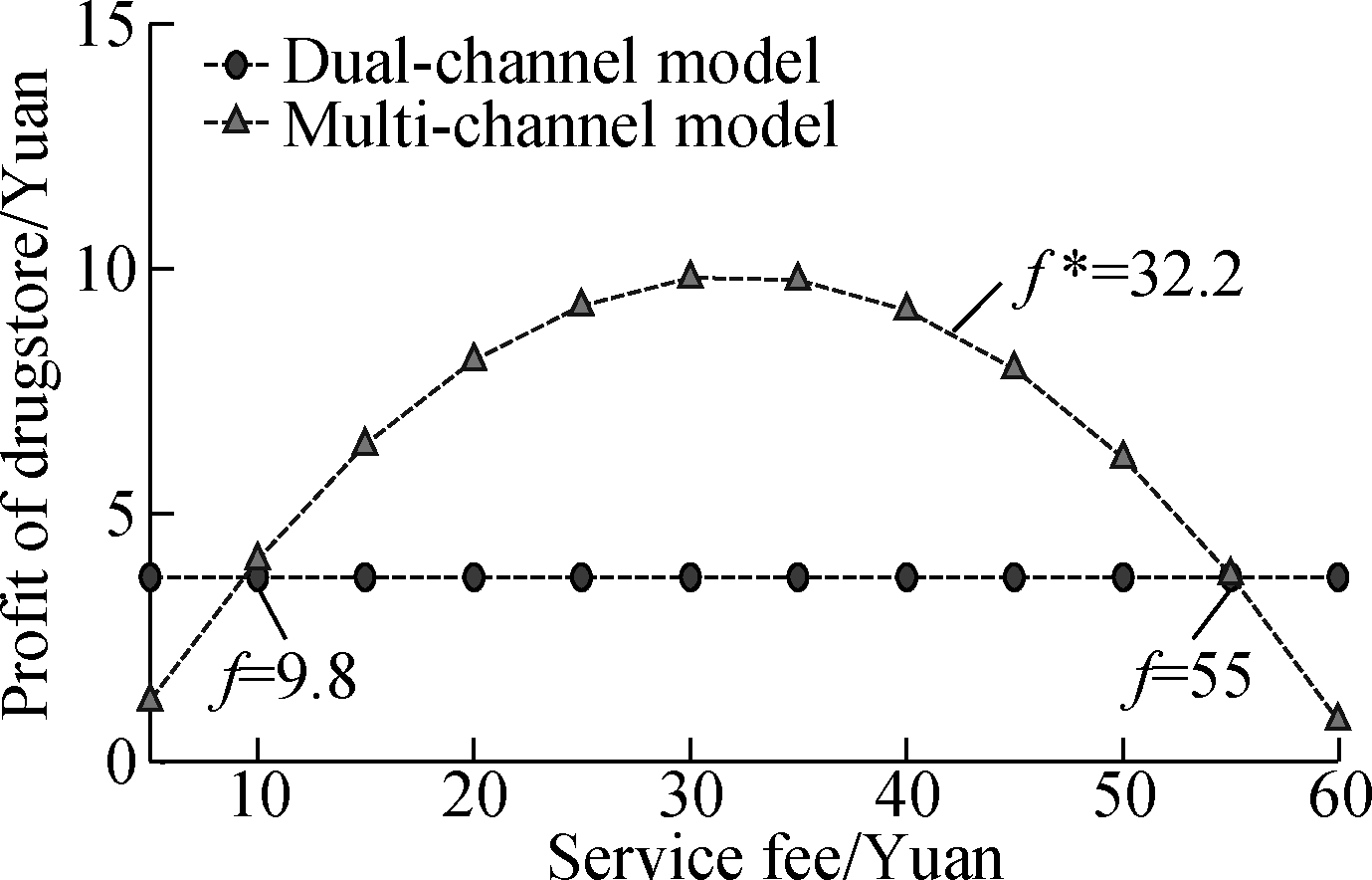
Fig.6 Profit of drugstore with service fee of dual-/multi-channel mode
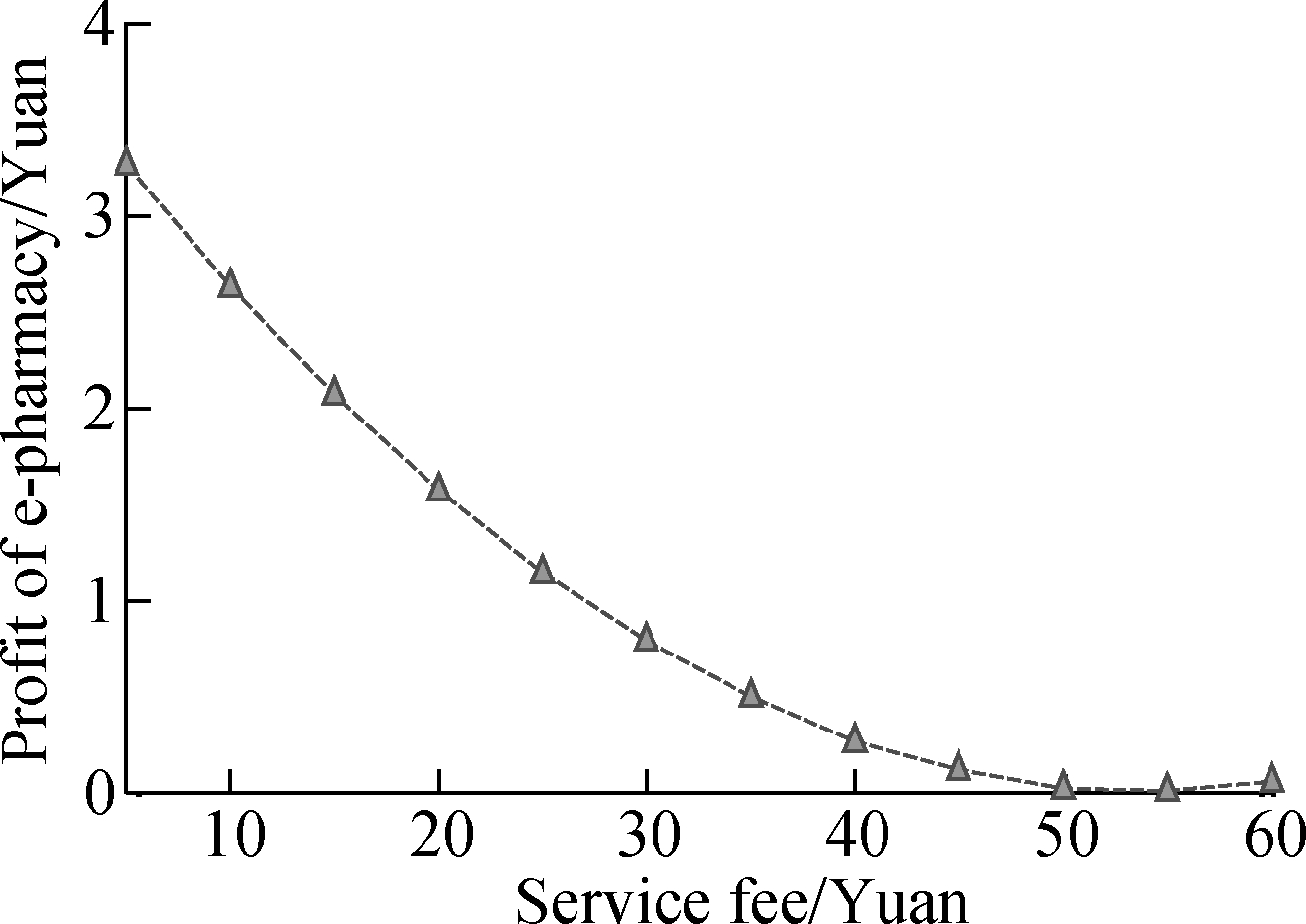
Fig.7 Profit of e-pharmacy with service fee of the multi-channel model
In this case, to ensure that the profit of the drugstore increases after the introduction of pharmaceutical e-commerce, the red line should be on top of the blue line in Fig.6. Therefore, the figure shows the service fee f∈(9.8,55). This specific scope provides a clear reference for the achievement of coordination. Moreover, the profit of the drugstore is concave during this range; there is an optimal value f=32.2 for the maximum profit. In Fig.7, it is indicated that the profit of the e-pharmacy decreases with the increasing service fee. Therefore, in this case, as long as the service fee stays in range (9.8,55), both the drugstore and e-pharmacy will accept the OODD strategy. On the other hand, the two figures indicate the validity of the OODD strategy and this specific scope plays a guiding role in promoting bilateral cooperation.
Let f=20, and we examine the effect of the change of other parameter values on the profits under the multi-channel model. The sensitivity analysis is performed by increasing the parameter values by 20%, taking one at a time and leaving the remaining values unchanged. The corresponding results are given in Tab.2.
Tab.2 Sensitivity analysis on the profits

ParametersProfit of the drugstore/%Profit of the e-pharmacy/%a-4.215.3o' 15.038.4ce -3.8-6.9
From Tab.2, we can see that the profits of the drugstore and the e-pharmacy ascend with the increasing outpatient fee o′ and decreasing home-delivery cost ce under the OODD strategy. When distance coefficient a increases, the profit of e-pharmacy increases but the profit of the drugstore decreases, which shows that the pharmaceutical e-commerce will develop better with the increase in residents’ income; and for the changing intervals, o′ has a strong influence, whereas a and ce comparatively exert a weaker influence. Thus, in the decision making context, the value of the outpatient fee should be emphasized to implement a successful OODD strategy.
3.2 Effect of drug pricing reform and improvement
In this section, we study the drug pricing reform from the perspective of retail prices and patients’ diversion, and then we examine the impacts of e-commerce on the profits of the manufacturer and hospital.
From Fig.8, we know that the drug pricing reform increases the retail price of drugstore. This is because the increase in outpatient fees is greater than the cancellation

Fig.8 Retail price of drugstore
tof drug price markups. As a result, the hospital increases the cost of purchasing drugs for patients and this eventually leads to a higher retail price of the drugstore. When the service fee f≤30.5, the retail price of the drugstore under he multi-channel model will be lower than that under the dual-channel model after reform and if the service fee continues to decrease; the retail price may even be lower than that under the dual-channel model before reform when f≤21.9. In Fig.9, the retail price of the e-pharmacy increases with the increasing service fee. Therefore, when the service fee is relatively low, the pharmaceutical e-commerce can reduce the retail prices of each channel. Next, we will analyze the patients’ diversion effect on pharmaceutical e-commerce.
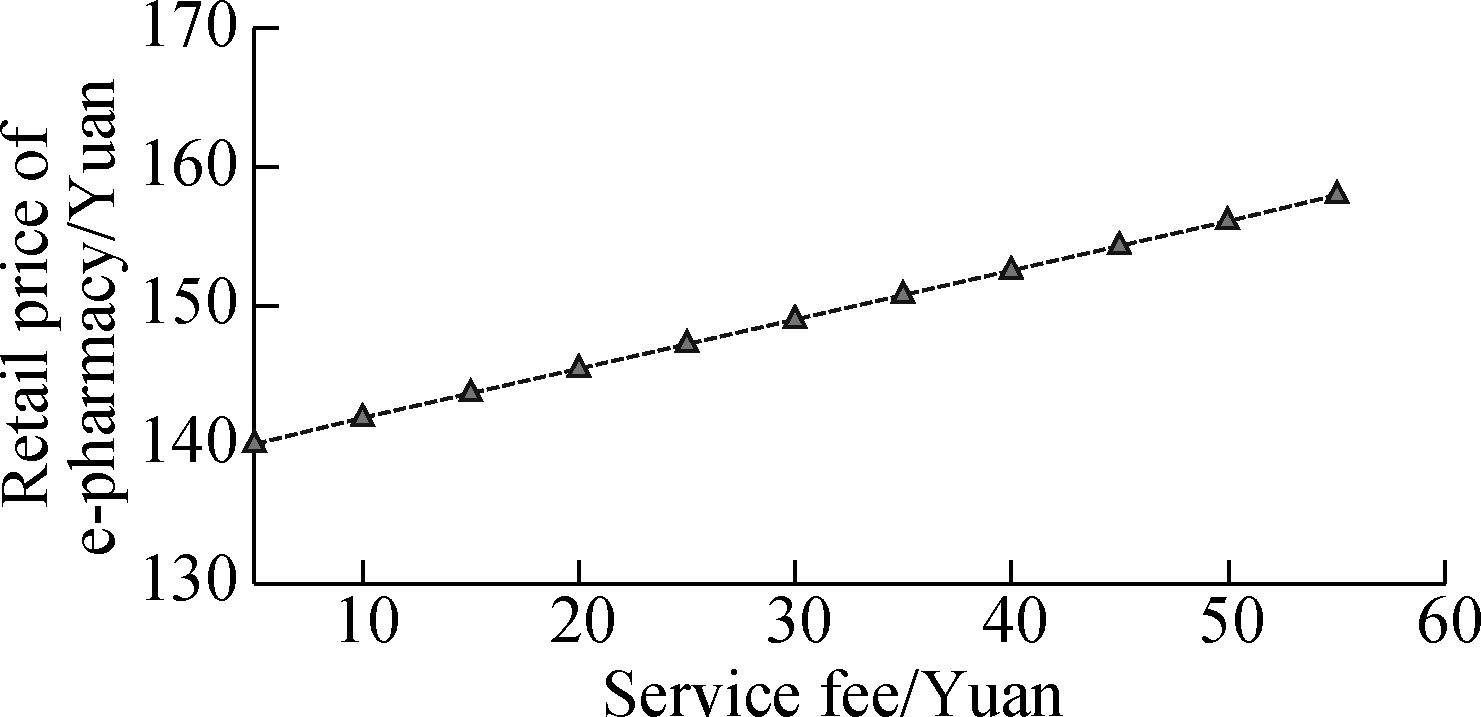
Fig.9 Retail price of e-pharmacy of the multi-channel model after reform
First, we analyze the effect of the drug pricing reform without pharmaceutical e-commerce. Based on Fig.10, the market share of hospital falls from 77% before the reform to 75% after that, which indicates that the reform diverts 2% of the patients. The effect of patients’ diversion is relatively very small. In Fig.11, we set the service fee f to be equal to 10, 32.2 and 55, respectively. We find that the market share of the e-pharmacy decreases with the increasing service fee. The pharmaceutical e-commerce diverts a large number of patients from the hospital when the service price is relatively low. However, when the service fee is high, a large number of patients will return to the hospital from the pharmacy and e-commerce channel.
Combining Fig.8 with Fig.11, the introduction of pharmaceutical e-commerce can simultaneously divert some patients from the hospital and decrease the retail prices when the service fee is relatively low, thus greatly improving the effect of the drug pricing reform. Then, the impacts of the OODD strategy on the profits of the manufacturer and hospital are studied.

Fig.10 Market share before and after reform
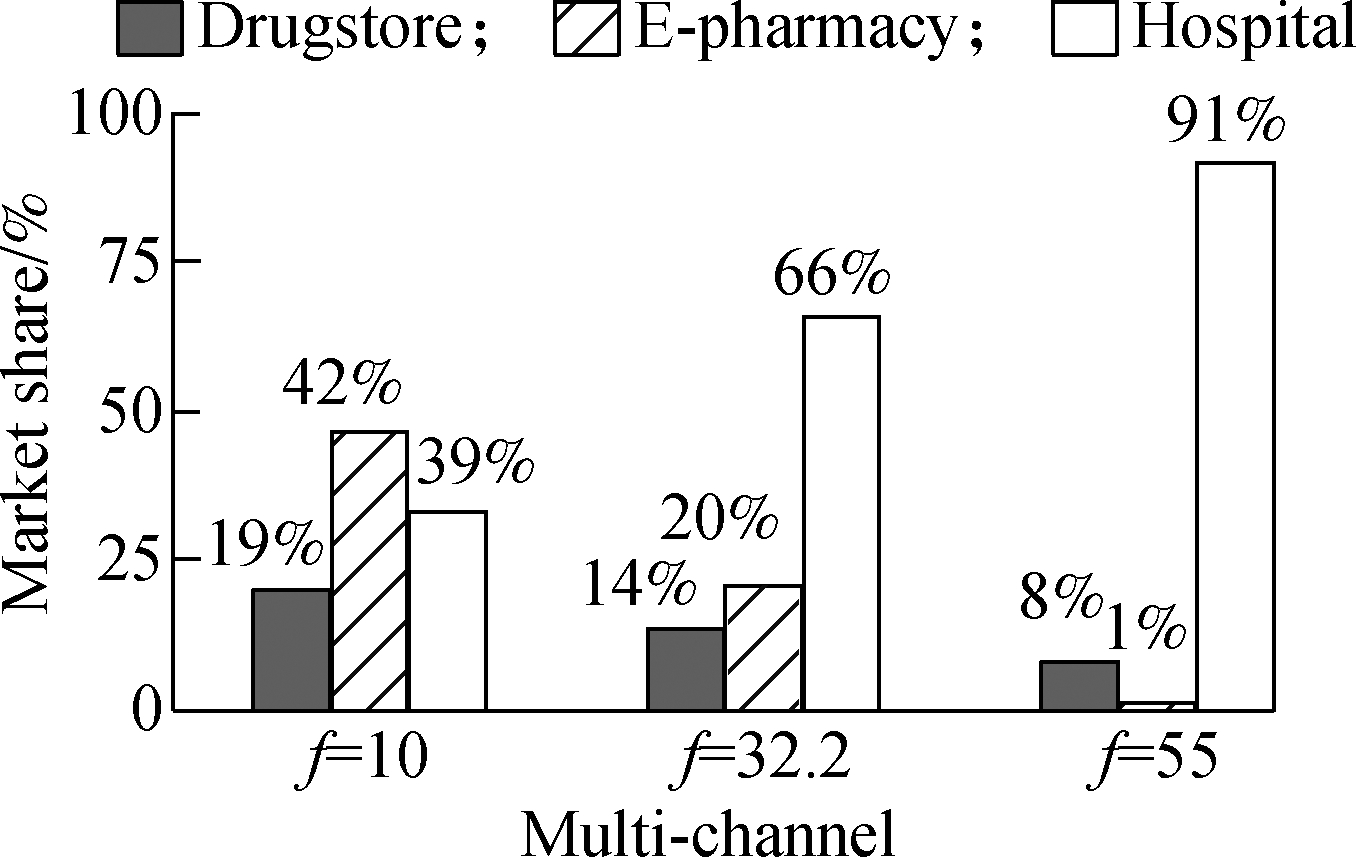
Fig.11 Market share under e-commerce environment
From Fig.12 and Fig.13, we know that the drug pricing reform increases the profits of the hospital and manufacturer. This is also because the increase in outpatient fees is higher than the decrease in the retail price of the hospital. After the introduction of pharmaceutical e-commerce, the profit of the hospital increases with the increasing service fee, while the profit of the pharmaceutical manufacturer changes in the opposite direction. It concludes that the e-commerce channel can limit the profit growth of the hospital when the service fee is relatively low. Therefore, the development of e-commerce plays a positive role in the reform of China’s medical system.

Fig.12 Profit of hospital

Fig.13 Profit of manufacturer
4 Conclusions
1) To improve the effect of drug pricing reform, the business model of pharmaceutical e-commerce and the “order online, delivery by drugstore” strategy are introduced to the pharmaceutical supply chain. This paper designs a cooperative service fee to ensure the feasibility of the online-offline coordination. Also, the range of the cooperative service fee is solved.
2) With numerical experiments, we find that a considerable number of patients are diverted from the hospital to other channels under the e-commerce scenario, and pharmaceutical e-commerce can lower the retail price at the drugstore because the e-channel increases the competition among channels.
3) In addition, for the profit of the drugstore, there is an optimal value for the service fee, which does not mean the higher the better. Therefore, the pharmaceutical e-commerce is an effective supplement for the suppression of prices rising after the drug pricing reform.
[1]Zeng J Y, Chen X W, Fu H Q, et al. Short-term and long-term unintended impacts of a pilot reform on Beijing’s zero markup drug policy: A propensity score-matched study[J]. BMC Health Services Research, 2019, 19: 916. DOI:10.1186/s12913-019-4764-z.
[2]Wang X D. Beijing medical care reform[EB/OL]. (2017-03-24)[2020-02-01]. http://www.chinadaily.com.cn /opinion/2017-03/24/content_28660140.htm.
[3]Chen L, Wu C, Guo Y, et al. Impacts of the drug markup reduction policy on hospital expenditures of esophageal cancer surgery inpatients in Shanghai, China[J].Public Health, 2020, 179: 118-126. DOI:10.1016/j.puhe.2019.09.023.
[4]Lin J N. Average profit margin of medical e-commerce is -5.5%[EB/OL]. (2016-12-01)[2020-02-01]. http://news.163.com/16/1201/06/C76A8NRE000187VE.html. (in Chinese)
[5]Yang L P, Liu C J, Ferrier J A, et al. The impact of the National Essential Medicines Policy on prescribing behaviours in primary care facilities in Hubei Province of China[J]. Health Policy and Planning, 2013, 28(7): 750-760. DOI:10.1093/heapol/czs116.
[6]Yi H M, Miller G, Zhang L X, et al. Intended and unintended consequences of China’s zero markup drug policy[J]. Health Affairs, 2015, 34(8): 1391-1398. DOI:10.1377/hlthaff.2014.1114.
[7]Luan M N, Shao X, Dou F M. Financial conditions, health care provision, and patient outcomes: Evidence from Chinese public hospitals[J]. Economics Letters, 2020, 186: 108876. DOI:10.1016/j.econlet.2019.108876.
[8]Liu S, Xu H, Cui X, et al. How the implementation of drug zero markup policy will affect health care expenditure inhospitals: Observation and prediction based on Zhejiang model[J]. Value in Health, 2014, 17(7): A790. DOI:10.1016/j.jval.2014.08.432.
[9]Zhou Z L, Su Y F, Campbell B, et al. The financial impact of the ‘zero-markup policy for essential drugs’ on patients in County hospitals in western rural China[J]. PLoS One, 2015, 10(3): e0121630. DOI:10.1371/journal.pone.0121630.
[10]Shi X F, Zhu D W, Man X W, et al. “The biggest reform to China’s health system”: Did the zero-markup drug policy achieve its goal at traditional Chinese medicines County hospitals?[J]. Health Policy and Planning, 2019, 34(7): 483-491. DOI:10.1093/heapol/czz053.
[11]Yang C J, Shen Q, Cai W F, et al. Impact of the zero-markup drug policy on hospitalisation expenditure in western rural China: An interrupted time series analysis[J]. Tropical Medicine & International Health, 2017, 22(2): 180-186. DOI:10.1111/tmi.12817.
[12]Wang H, Tang Y, Liu Y, et al. Effect evaluation of national essential medicine system in China: Based on survey data from Shandong, Hubei and Sichuan[J]. Chinese Journal of Health Policy, 2012, 5(4): 30-34. DOI:10.3969/j.issn.1674-2982.2012.04.006. (in Chinese)
[13]Saha S, Sarmah S P, Moon I. Dual channel closed-loop supply chain coordination with a reward-driven remanufacturing policy[J]. International Journal of Production Research, 2016, 54(5): 1503-1517. DOI:10.1080/00207543.2015.1090031.
[14]Xu G Y, Dan B, Zhang X M, et al. Coordinating a dual-channel supply chain with risk-averse under a two-way revenue sharing contract[J]. International Journal of Production Economics, 2014, 147: 171-179. DOI:10.1016/j.ijpe.2013.09.012.
[15]Xiao T J, Qi X T. A two-stage supply chain with demand sensitive to price, delivery time, and reliability of delivery[J]. Annals of Operations Research, 2016, 241(1/2): 475-496. DOI:10.1007/s10479-012-1085-6.
[16]Liao P, Ye F, Wu X L. A comparison of the merchant and agency models in the hotel industry[J]. International Transactions in Operational Research, 2019, 26(3): 1052-1073. DOI:10.1111/itor.12365.
[17]Dan B, Liu C, Xu G Y, et al. Pareto improvement strategy for service-based free-riding in a dual-channel supply chain[J]. Asia-Pacific Journal of Operational Research, 2014,31(6):1450050.DOI:10.1142/s021759591450050x.
[18]Dumrongsiri A, Fan M, Jain A, et al. A supply chain model with direct and retail channels[J]. European Journal of Operational Research, 2008, 187(3): 691-718. DOI:10.1016/j.ejor.2006.05.044.
[19]Amrouche N, Pei Z, Yan R L. Mobile channel and channel coordination under different supply chain contexts[J]. Industrial Marketing Management, 2020, 84: 165-182. DOI:10.1016/j.indmarman.2019.06.001.
[20]Pei Z, Yan R L. Cooperative behavior and information sharing in the e-commerce age[J]. Industrial Marketing Management, 2019, 76: 12-22. DOI:10.1016/j.indmarman.2018.06.013.
[21]Chen X, Wang X J, Jiang X K. The impact of power structure on the retail service supply chain with an O2O mixed channel[J]. Journal of the Operational Research Society, 2016, 67(2): 294-301. DOI:10.1057/jors.2015.6.
[22]Gao F, Su X M. Omnichannel retail operations with buy-online-and-pick-up-in-store[J]. Management Science, 2017, 63(8): 2478-2492. DOI:10.1287/mnsc.2016.2473.
[23]Gallino S, Moreno A. Integration of online and offline channels in retail: The impact of sharing reliable inventory availability information[J].Management Science, 2014, 60(6): 1434-1451. DOI:10.1287/mnsc.2014.1951.
[24]Liu J R, Xu Q. Joint decision on pricing and ordering for omnichannel BOPS retailers: Considering online returns[J]. Sustainability, 2020, 12(4): 1539. DOI:10.3390/su12041539.
[25]Jiang Y Q, Liu L P, Lim A. Optimal pricing decisions for an omni-channel supply chain with retail service[J]. International Transactions in Operational Research, 2020, 27(6): 2927-2948. DOI:10.1111/itor.12784.
[26]Zhang P, He Y, Zhao X. “Preorder-online, pickup-in-store” strategy for a dual-channel retailer[J].Transportation Research Part E: Logistics and Transportation Review, 2019, 122: 27-47. DOI:10.1016/j.tre.2018.11.001.
[27]Yue X H, Liu J. Demand forecast sharing in a dual-channel supply chain[J]. European Journal of Operational Research, 2006, 174(1): 646-667. DOI:10.1016/j.ejor.2004.12.020.
[28]Huang W, Swaminathan J M. Introduction of a second channel: Implications for pricing and profits[J].European Journal of Operational Research, 2009, 194(1): 258-279. DOI:10.1016/j.ejor.2007.11.041.
[29]Hua G W, Wang S Y, Cheng T C E. Price and lead time decisions in dual-channel supply chains[J]. European Journal of Operational Research, 2010, 205(1): 113-126. DOI:10.1016/j.ejor.2009.12.012.
[30]Hotelling H. Stability in competition[J]. The Economic Journal, 1929, 39(153): 41. DOI:10.2307/2224214.
[31]Larralde H, Stehlé J, Jensen P. Analytical solution of a multi-dimensional Hotelling model with quadratic transportation costs[J].Regional Science and Urban Economics, 2009, 39(3): 343-349. DOI:10.1016/j.regsciurbeco.2009.01.001.